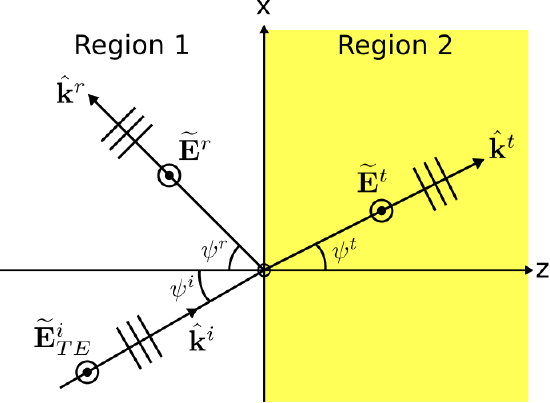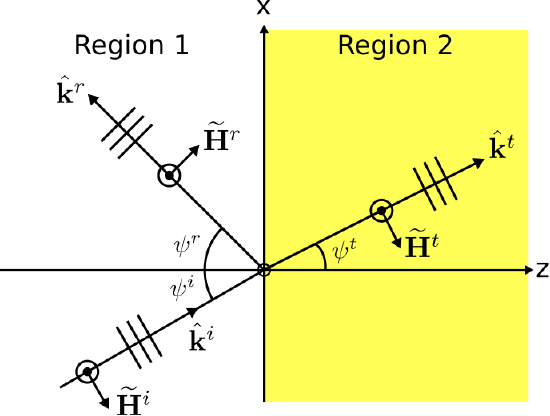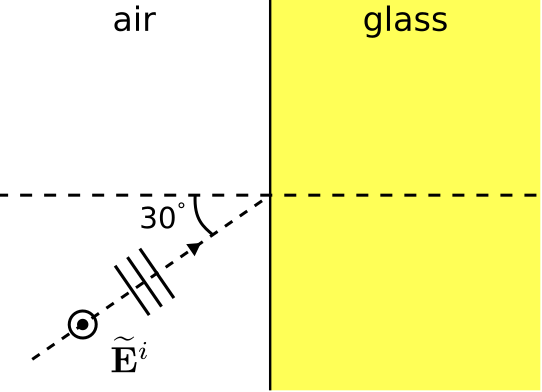5.6: Plane Waves at Oblique Incidence on a Planar Boundary- TE Case
( \newcommand{\kernel}{\mathrm{null}\,}\)
In this section, we consider the problem of reflection and transmission from a planar boundary between semi-infinite media for a transverse electric (TE) uniform plane wave. Before attempting this section, a review of Sections 5.1 (“Plane Waves at Normal Incidence on a Planar Boundary Between Lossless Media”) and 5.5 (“Decomposition of a Wave into TE and TM Components”) is recommended. Also, note that this section has much in common with Section 5.7 (“Plane Waves at Oblique Incidence on a Planar Boundary: TM Case”), although it is recommended to attempt the TE case first.
The TE case is illustrated in Figure 5.6.1.
 Figure 5.6.1: A TE uniform plane wave obliquely inciden ton the planar boundary between two semi-infinite material regions. ( CC BY-SA 4.0; C. Wang)
Figure 5.6.1: A TE uniform plane wave obliquely inciden ton the planar boundary between two semi-infinite material regions. ( CC BY-SA 4.0; C. Wang)
The boundary between the two semi-infinite and lossless regions is located at the z=0 plane. The wave is incident from Region 1. The electric field intensity ˜EiTE of this wave is given by
˜EiTE(r)=ˆyEiTEe−jki⋅r
In this expression, r is the position at which ˜EiTE is evaluated, and
ki=ˆkiβ1
where ˆki is the unit vector indicating the direction of propagation and β1=ω√μ1ϵ1 is the phase propagation constant in Region 1. ˜EiTE serves as the “stimulus” in this problem, so all other contributions to the total field will be expressed in terms of quantities appearing in Equation ???.
The presence of reflected and transmitted uniform plane waves is inferred from our experience with the normal incidence scenario (Section 5.1). There, as here, the symmetry of the problem indicates that the reflected and transmitted components of the electric field will have the same polarization as that of the incident electric field. This is because there is nothing present in the problem that could account for a change in polarization. Thus, the reflected and transmitted fields will also be TE. Therefore, we postulate the following expression for the reflected wave:
˜Er(r)=ˆyBe−jkr⋅r
where B is an unknown, possibly complex-valued constant to be determined and
kr=ˆkrβ1
indicates the direction of propagation, which is also currently unknown.
Similarly, we postulate the following expression for the transmitted wave:
˜Et(r)=ˆyCe−jkt⋅r
where C is an unknown, possibly complex-valued constant to be determined;
kt=ˆktβ2
where ˆkt is the unit vector indicating the direction of propagation; and β2=ω√μ2ϵ2 is the phase propagation constant in Region 2.
At this point, the unknowns in this problem are the constants B and C, as well as the directions ˆkr and ˆkt. We may establish a relationship between EiTE, B, and C by application of boundary conditions at z=0. First, recall that the tangential component of the total electric field intensity must be continuous across material boundaries. To apply this boundary condition, let us define ˜E1 and ˜E2 to be the total electric fields in Regions 1 and 2, respectively. The total field in Region 1 is the sum of incident and reflected fields, so
˜E1(r)=˜EiTE(r)+˜Er(r)
The total field in Region 2 is simply
˜E2(r)=˜Et(r)
Next, note that all electric field components are already tangent to the boundary. Thus, continuity of the tangential component of the electric field across the boundary requires ˜E1(0)=˜E2(0), and therefore
˜EiTE(r0)+˜Er(r0)=˜Et(r0)
where r=r0≜ˆxx+ˆyy since z=0 on the boundary. Now employing Equations ???, ???, and ???, we obtain:
ˆyEiTEe−jki⋅r0+ˆyBe−jkr⋅r0=ˆyCe−jkt⋅r0
Dropping the vector (ˆy) since it is the same in each term, we obtain:
EiTEe−jki⋅r0+Be−jkr⋅r0=Ce−jkt⋅r0
For Equation ??? to be true at every point r0 on the boundary, it must be true that
ki⋅r0=kr⋅r0=kt⋅r0
Essentially, we are requiring the phases of each field in Regions 1 and 2 to be matched at every point along the boundary. Any other choice will result in a violation of boundary conditions at some point along the boundary. This phase matching criterion will determine the directions of propagation of the reflected and transmitted fields, which we shall do later.
First, let us use the phase matching criterion to complete the solution for the coefficients B and C. Enforcing Equation ???, we observe that Equation ??? reduces to:
EiTE+B=C
A second equation is needed since we currently have only one equation (Equation ???) and two unknowns (B and C). The second equation is obtained by applying the appropriate boundary conditions to the magnetic field. The magnetic field associated with each of the electric field components is identified in Figure 5.6.2.
 Figure 5.6.2: Incident, reflected, and transmittted magnetic field components associated witht he TE electric field components shown in Figure 5.6.1. ( CC BY-SA 4.0; C. Wang)
Figure 5.6.2: Incident, reflected, and transmittted magnetic field components associated witht he TE electric field components shown in Figure 5.6.1. ( CC BY-SA 4.0; C. Wang)
Note the orientations of the magnetic field vectors may be confirmed using the plane wave relationships: Specifically, the cross product of the electric and magnetic fields should point in the direction of propagation. Expressions for each of the magnetic field components is determined formally below.
From the plane wave relationships, we determine that the incident magnetic field intensity is
˜Hi(r)=1η1ˆkiטEiTE
where η1=√μ1/ϵ1 is the wave impedance in Region 1. To make progress requires that we express ˆki in the global fixed coordinate system. Here it is:
ˆki=ˆxsinψi+ˆzcosψi
Thus:
˜Hi(r)=(ˆzsinψi−ˆxcosψi)EiTEη1e−jki⋅r
Similarly, we determine that the reflected magnetic field has the form:
˜Hr(r)=1η1ˆkrטEr
In the global coordinate system:
ˆkr=ˆxsinψr−ˆzcosψr
Thus:
˜Hr(r)=(ˆzsinψr+ˆxcosψr)Bη1e−jkr⋅r
The transmitted magnetic field has the form:
˜Ht(r)=1η2ˆktטEt
In the global coordinate system:
ˆkt=ˆxsinψt+ˆzcosψt
Thus:
˜Ht(r)=(ˆzsinψt−ˆxcosψt)Cη2e−jkt⋅r
The total magnetic field in Region 1 is the sum of incident and reflected fields, so
˜H1(r)=˜Hi(r)+˜Hr(r)
The magnetic field in Region 2 is simply
˜H2(r)=˜Ht(r)
Since there is no current on the boundary, the tangential component of the total magnetic field intensity must be continuous across the boundary. Expressed in terms of the quantities already established, this boundary condition requires:
ˆx⋅˜Hi(r0)+ˆx⋅˜Hr(r0)=ˆx⋅˜Ht(r0)
where “ˆx⋅” selects the component of the magnetic field that is tangent to the boundary. Evaluating this expression, we obtain:
−(cosψi)EiTEη1e−jki⋅r0+(cosψr)Bη1e−jkr⋅r0=−(cosψt)Cη2e−jkt⋅r0
Now employing the phase matching condition expressed in Equation ???, we find:
−(cosψi)EiTEη1+(cosψr)Bη1=−(cosψt)Cη2
Equations ??? and 5.6.28 comprise a linear system of equations with unknowns B and C. This system of equations is easily solved for B as follows. First, use Equation ??? to eliminate C in Equation 5.6.28. The result is:
−(cosψi)EiTEη1+(cosψr)Bη1=−(cosψt)EiTE+Bη2
Solving this equation for B, we obtain:
B=η2cosψi−η1cosψtη2cosψr+η1cosψt EiTE
We can express this result as a reflection coefficient as follows:
B=ΓTEEiTE
where
ΓTE≜η2cosψi−η1cosψtη2cosψr+η1cosψt
It is worth noting that Equation ??? becomes the reflection coefficient for normal (TEM) incidence when ψi=ψr=ψt=0, as expected.
Returning to Equation ???, we now find
C=(1+ΓTE)EiTE
Let us now summarize the solution. Given the TE electric field intensity expressed in Equation ???, we find:
˜Er(r)=ˆyΓTEEiTEe−jkr⋅r
˜Et(r)=ˆy(1+ΓTE)EiTEe−jkt⋅r
This solution is complete except that we have not yet determined ˆkr, which is now completely determined by ψr via Equation ???, and ˆkt, which is now completely determined by ψt via Equation ???. In other words, we have not yet determined the directions of propagation ψr for the reflected wave and ψt for the transmitted wave. However, ψr and ψi can be found using Equation ???. Here we shall simply state the result, and in Section 5.8 we shall perform this part of the derivation in detail and with greater attention to the implications. One finds:
ψr=ψi
and
ψt=arcsin(β1β2sinψi)
Equation ??? is the unsurprising result that angle of reflection equals angle of incidence. Equation ??? – addressing angle of transmission – is a bit more intriguing. Astute readers may notice that there is something fishy about this equation: It seems possible for the argument of arcsin to be greater than one. This oddity is addressed in Section Section 5.8.
Finally, note that Equation ??? allows us to eliminate ψr from Equation ???, yielding:
ΓTE=η2cosψi−η1cosψtη2cosψi+η1cosψt
Thus, we obtain what is perhaps the most important finding of this section:
The electric field reflection coefficient for oblique TE incidence, ΓTE, is given by Equation ???.
The following example demonstrates the utility of this result.
Figure 5.6.3 illustrates a TE plane wave incident from air onto the planar boundary with glass. The glass exhibits relative permittivity of 2.1. Determine the power reflected and transmitted relative to power incident on the boundary.
 Figure 5.6.3: A TE uniform plane wave incident from air to glass. ( CC BY-SA 4.0; C. Wang)
Figure 5.6.3: A TE uniform plane wave incident from air to glass. ( CC BY-SA 4.0; C. Wang)
Solution
The power reflected relative to power incident is |ΓTE|2 whereas the power transmitted relative to power incident is 1−|ΓTE|2. ΓTE may be calculated using Equation ???. Calculating the quantities that enter into this expression:
η1≈η0≅376.7 Ω (air)
η2≈η0√2.1≅260.0 Ω (glass)
ψi=30∘
Note
β1β2≈ω√μ0ϵ0ω√μ0⋅2.1ϵ0≅0.690
so
ψt=arcsin(β1β2sinψi)≅20.2∘
Now substituting these values into Equation ???, we obtain
ΓTE≅−0.2220
Subsequently, the fraction of power reflected relative to power incident is |ΓTE|2≅0.049; i.e., about 4.9%. 1−|ΓTE|2≅95.1% of the power is transmitted into the glass.


